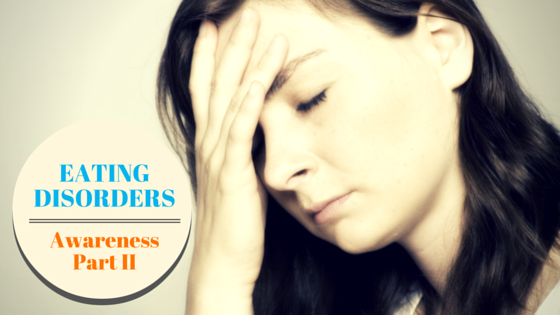
In part 2 of the series on eating disorder awareness, we will take a look at the currently available treatments for eating disorders and how stem cells may be used to treat eating disorders in the future.
Eating Disorders are very serious health conditions that can be very destructive, both physically and emotionally. An eating disorder is not a trivial problem, after all, eating disorders have the highest mortality rate of any mental illness (Anad.org, 2016).
People who suspect they may have an eating disorder should immediately seek professional help and receive treatment. By receiving treatment as soon as possible a person with an eating disorder can reduce the risk that the illness becomes a chronic and long-term condition.
A medical professional will assess the severity of the eating disorder before determining the initial level of treatment. The levels of treatment include:
- Outpatient Care Eating Disorder Treatment
This is the least restrictive level of care. The patient will see a nutritionist, doctor and/or therapist between 2 to 3 times per week.
- Intensive Outpatient Eating Disorder Treatment
If the patient requires more support, they will meet with medical professionals more often and have more highly specialised medical care. In addition to working with a nutritionist, doctor and therapist, they may participate in topic focussed groups.
- Residential Eating Disorders Treatment
Patients will move into a treatment facility, where they will receive 24-hour care and be place under constant medical supervision.
- Inpatient/Hospital Eating Disorder Treatment
The patient will be moved into a hospital with the goal of medical stabilisation and prevention of further weight loss. Typically, these kinds of visits are restricted to a few weeks or less. Once the patient is stable, they will return to a treatment facility.
Eating Disorder Treatments
There are a wide range of therapies available that have been proven to be effective, including:
1. Cognitive Behavioral Therapy (CBT)
A form of psychotherapy that focusses on eliminating negative thinking. CBT can help people struggling with any eating disorder.
2. Medical Nutrition Therapy
A dietician will work with the patient, assessing their current diet then creating a set of meal plans designed to fulfil their nutritional requirements.
3. Dialectical Behavioural Therapy (DBT)
Dialectical Behavioural Therapy (DBT) is another form of psychotherapy that uses cognitive and behavioural techniques to help deal with painful emotions.
4. Art Therapy and Dance Movement Therapy
Both artistic creations and dancing have been proven to help people express their emotions. It helps patients control their emotions when it comes to food.
5. Acceptance and Commitment Therapy (ACT)
This therapy helps the patient be more aware of their emotions and to take charge of their behaviour.
6. Exposure and Response Prevention Therapy (ERP)
This therapy is designed to help people overcome their fears and anxieties. Patients are exposed to the feared object or circumstance gradually to become desensitised to it.
7. Interpersonal Psychotherapy (IPT)
This is a form of therapy designed to help patients deal with any emotional problems they have in their life. Underlying personal issues are discussed and the anxiety from those issues is gradually subdued.
Can Stem Cells Treat Eating Disorders?
Some researchers believe there may be a relationship between the stem cells in the adult brain and eating disorders including anorexia, bulimia and binge eating. Dr Mohammad K Hajihosseini suggests that because the circuits controlling appetite are within the brain, it may be possible to manipulate them or use neural stem cells to correct problems.
Working in conjunction with scientists from the UK, Finland and Germany, Dr Hajihosseini has found a link between a specific type of neural stem cell called tanycytes and the regulation of appetite (International Innovation, 2014).
The scientists were researching the role of the hypothalamus to regulate appetite when they discovered tanycytes were create appetite-regulating nerve cells. Scientists may be able to manipulate these stem cells, causing them to renew nerve cells in the brain that change how a person experiences appetite. Such a treatment has the potential to cure anorexia nervosa.
Dr. Stormy Chamberlain from the UConn Health Center in Farmington, is trying to develop a treatment for a rare genetic disease that causes eating disorders. The disease, known as Prader-Willi Syndrome, causes sufferers to have an insatiable appetite, short stature, behavioural problems and poor muscle tone. Dr Chamberlain has received funding from the United States government for stem cell research and hopes to develop a treatment for this disease in the coming years (Mirror, 2012).
As scientists begin to learn more about the complex relationship between the brain and the rest of the body, they may uncover more potential treatments for eating disorders. Until then, most treatment methods will rely on psychotherapy and improvements to a patients diet. For people who believe they may have developed an eating disorder, it is always important to seek professional help immediately, before the illness becomes life threatening.
Sources
Anad.org,. (2016). Eating Disorders Statistics – National Association of Anorexia Nervosa and Associated Disorders. Retrieved 18 February 2016, from http://www.anad.org/get-information/about-eating-disorders/eating-disorders-statistics/
Eating Disorder Hope,. (2016). Eating Disorder Therapies & Treatment Types | Eating Disorder Hope. Retrieved 20 February 2016, from http://www.eatingdisorderhope.com/treatment-for-eating-disorders/types-of-treatments#Levels-and-Types-of-Eating-Disorder-Treatment
International Innovation,. (2014). Neurogenesis, networks and eating habits – International Innovation. Retrieved 21 February 2016, from http://www.internationalinnovation.com/neurogenesis-networks-and-eating-habit/
Nationaleatingdisorders.org,. (2016). Treating an Eating Disorder | National Eating Disorders Association. Retrieved 20 February 2016, from http://www.nationaleatingdisorders.org/treating-eating-disorder
Mirror, T. (2012). Stem cell research: UConn professor tracks cause of rare, genetic eating disorder. The CT Mirror. Retrieved 21 February 2016, from http://ctmirror.org/2012/06/26/stem-cell-research-uconn-professor-tracks-cause-rare-genetic-eating-disorder/


